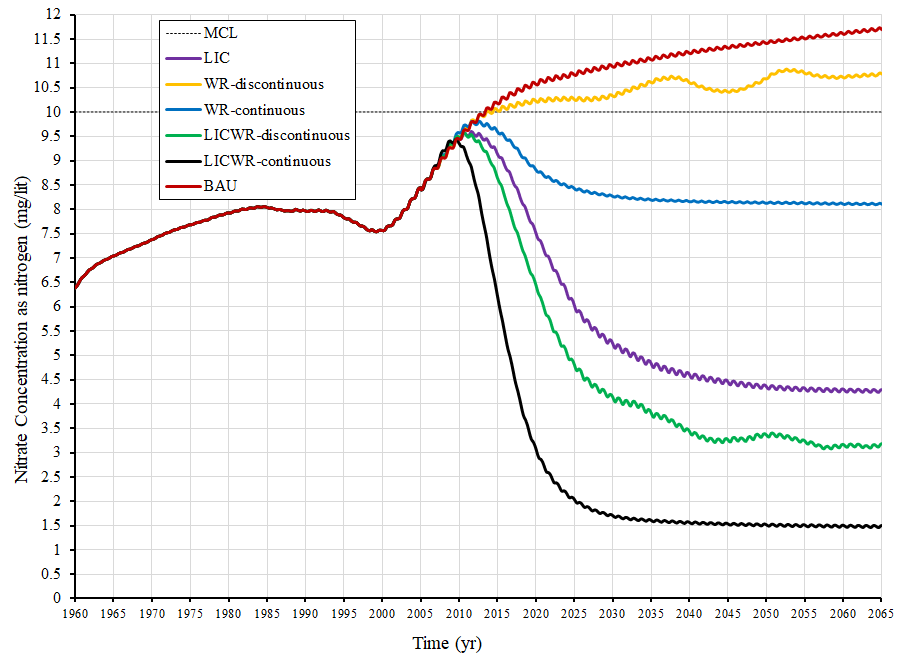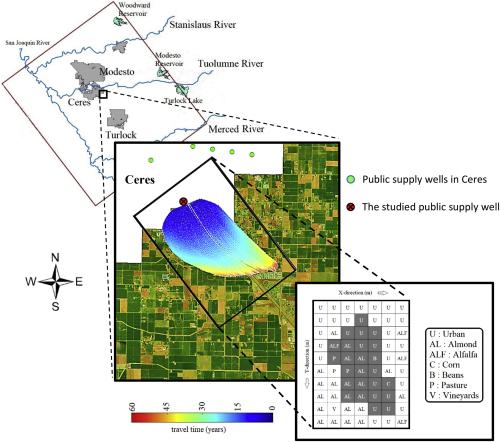Nitrate in drinking water may cause serious health problems for consumers. Agricultural activities are known to be the main source of groundwater nitrate contaminating rural domestic and urban public water supply wells in farming regions. Management practices have been proposed to reduce the amount of nitrate in groundwater, including improved nutrient management practices and “pump and fertilize” with nitrate-affected irrigation wells. Simultaneously, recent drought conditions and the implementation of groundwater sustainability plans (GSPs) have put much focus on managed aquifer recharge in agricultural landscapes (AgMAR or FloodMAR).
We evaluated the long-term impacts of AgMAR in the source area of public water supply wells. We also compare the groundwater quality effects of AgMAR to those of improved nutrient management, and to combinations of both AgMAR and improved nutrient management.
Our tool is a newly developed numerical model of nitrate fate and transport was developed for the Modesto basin, part of California's Central Valley aquifer system. The basin is representative of semi-arid agricultural regions around the world with a diversity of crop types, overlying an unconsolidated sedimentary aquifer system. A local public supply well in an economically disadvantaged community surrounded by farmland was the focus of this study.
Alternative nutrient management and recharge practices are shown to act as remediation tools in the area between farmland and the public supply well. Improved agricultural source area management practices are shown to be an effective tool to maintain or even enhance groundwater quality in the targeted supply well while remediating ambient groundwater.
Best results are obtained when lowering nitrate load while also increasing recharge in the source area simultaneously. This scenario reduced nitrate in the supply well's drinking water by 80% relative to the business as usual scenario. It also remediated ambient groundwater used by domestic wells between the source area farmlands and the supply well and showed 60% more reduction of nitrate after 60 years of application. Increasing recharge led to shorter initial response time (five years) and showed the most sustainable impact.
Our analysis further suggests that Ag-MAR in a highly discontinuous, wide-spread pattern leads to slow water quality response and may not yield sufficient water quality improvements.
Another question addressed in this study is the role of legacy load in AgMAR: legacy loads are shown to be already moving toward drinking water wells. AgMAR in the source area of a supply well slightly accelerating the upward nitrate trends in the supply well for a relatively short interim period. After one to three years, trends are reversed due to AgMAR leading to much improved water quality in the longer term.
 Figure 1: This graph shows the simulated nitrate concentration in a public supply well of an economically disadvantaged community in the Central Valley that impacted by nitrate from surrounding agricultural areas. In these simulations, the "future" starts in 2005. Under the business-as-usual (BAU) scenario, no changes occur in the land use or management from pre-2005. Other, managed future scenarios include "low-intensity-crop" (LIC), a replacement with crops that are not as nutrient intensive or management of nutrients to much higher efficiency; and "winter-recharge" (WR) scenarios, aka AgMAR, implemented each winter ("WR-continuous") or only in water years with high flood flows in nearby rivers ("WR-discontinuous"). Combinations of nutrient management (LIC) and AgMAR (WR) are also evaluated ("LICWR-continuous" and "LICWR-discontinuous"). The black dashed line represents the drinking water maximum contamination level (MCL) for nitrate-N (10 mg/L).
Figure 1: This graph shows the simulated nitrate concentration in a public supply well of an economically disadvantaged community in the Central Valley that impacted by nitrate from surrounding agricultural areas. In these simulations, the "future" starts in 2005. Under the business-as-usual (BAU) scenario, no changes occur in the land use or management from pre-2005. Other, managed future scenarios include "low-intensity-crop" (LIC), a replacement with crops that are not as nutrient intensive or management of nutrients to much higher efficiency; and "winter-recharge" (WR) scenarios, aka AgMAR, implemented each winter ("WR-continuous") or only in water years with high flood flows in nearby rivers ("WR-discontinuous"). Combinations of nutrient management (LIC) and AgMAR (WR) are also evaluated ("LICWR-continuous" and "LICWR-discontinuous"). The black dashed line represents the drinking water maximum contamination level (MCL) for nitrate-N (10 mg/L).

Bastani M. and T. Harter (2019), Source area management practices as remediation tool to address groundwater nitrate pollution in drinking supply wells. J. of Contaminant Hydrology 226, 103521, doi:10.1016/j.jconhyd.2019.103521 (open access).
